Extended Depth of Field Photography of
Insects et.al.
Rik Littlefield (email
rj.littlefield at computer.org)
Last major modification Aug 7, 2005
Last minor edit May 22, 2007
Reference
Much of the material described below has been condensed into an article
published in the Summer 2005 issue of News of the Lepidopterists'
Society. You might want to start there and then come back
here for earlier material that may be more complete but draftier.
Background
Shallow depth of field is a problem when photographing small
things. Stopping down the lens is not a solution.
Beyond
some optimum point, stopping down the lens reduces geometric blur but
makes the entire image fuzzy due to diffraction effects. When
photographing something the size of a housefly, the optimum point is
typically f/8 or wider, and the useful depth of field ("depth of
detail") for a single picture is often 0.1 mm or less. The
problem becomes more severe with smaller subjects.
Recent advances in digital photography software address this problem by
allowing the photographer to shoot a "stack" of images, sweeping the
plane of ideal focus across the subject, then combining the in-focus
portions of each image to construct a final image that is sharp
everywhere. Using current computers and digital cameras, it is
quite practical to use 100 or more different focus planes, thus
extending useful depth of field from 0.1 mm to 10.0 mm (for
example). Of course, this technique requires that the subject
does not move while the image stack is being shot. Only dead or
thoroughly immobile specimens can be used.
Software
The software used here is CombineZ5,
a free program written by Alan Hadley. Several commercial
products, notably Helicon
Focus, can do pretty much the same job and are significantly easier
to use. However, for difficult subjects such as overlapping
hairs, I have gotten the best final results using CombineZ5.
(Tuning parameters for new situations is a bit tricky, but with
experience, good results should become easy to obtain.)
Examples
Here is the head of a Sulphur butterfly (Colias, species unknown), using a
stack of 53 frames separated by 0.005 in (0.125 mm), shot at f/8 using
a 50mm El Nikkor enlarging lens, reversed. (This is the optimum
aperture for this lens at this magnification.). Subject width is
about 6 mm.
Run your mouse over the image to see a single frame from the
camera.
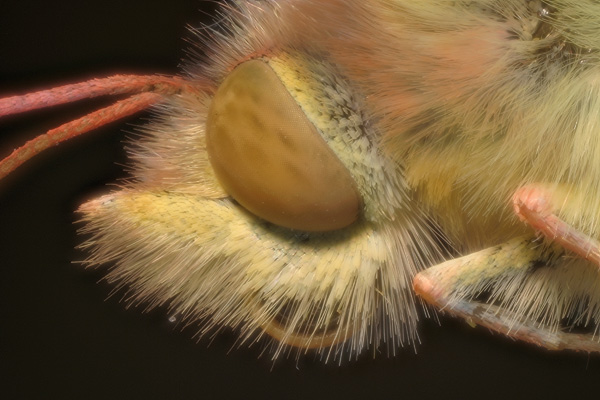
A stereo pair of this image can be seen at http://www.janrik.net/insects/ExtendedDOF/SulphurStereoDE.html
.
The original of the above image is 3000x2000 pixels and contains much
too much detail to show on this web
page. Here is a small crop from next to the eye. Note
that this level of detail is maintained over the entire head of the
butterfly. Click on this image to open full size in a new
window. (Depending on which browser you're using, you may
need to click another button or two to see it full size, or you can
save it to disk and look at it with your favorite image viewer.)
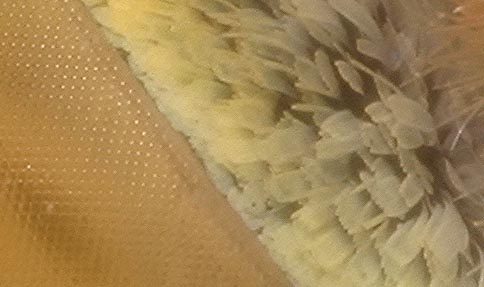
Here's another example -- part of the eye and labial palp of a Painted
Lady Butterfly. Subject width is about 3 mm. 92 frames
spaced by 0.001 inch. Click on the
image to open full size in a new window. (The full size image is
1480x980 pixels.) This particularly difficult test case is
discussed in more detail on its own
page.
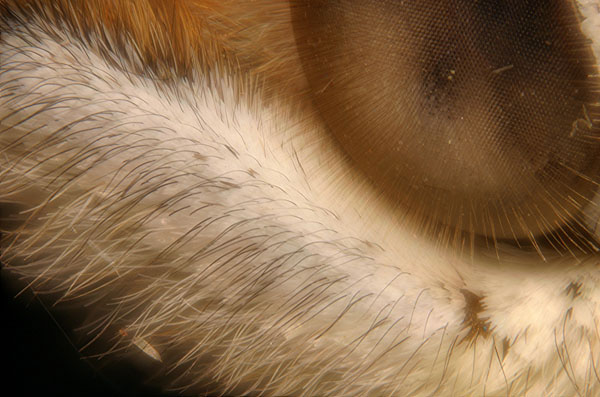
Here's the egg of an Icaricia lupini
butterfly ("Lupine Blue", despite that it eats only buckwheat (Eriogonum)).
See stereo renditions and further explanation on this page.
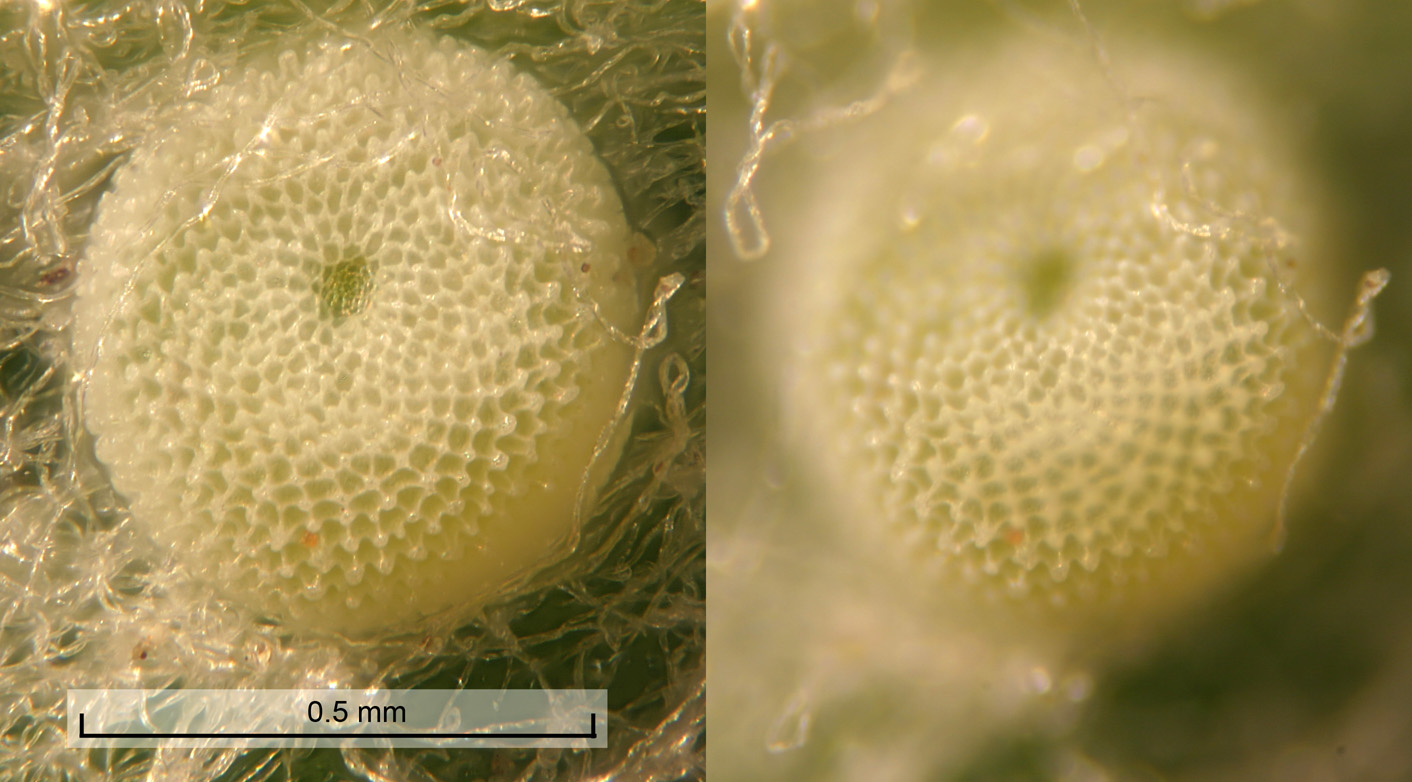
Physical Setup
See photo below. The Canon Digital Rebel (D300) camera is held in
a 2-axis machining vise, permitting convenient lateral and focusing
movement in calibrated 0.001 inch increments. The specimen is
held in an ancient homebrew positioning device that provides a similar
degree of control over vertical movements. The lens is mounted on
a homebrew collection of bellows, extension tubes, and Pentax-thread
adapters. Click to open full sized.
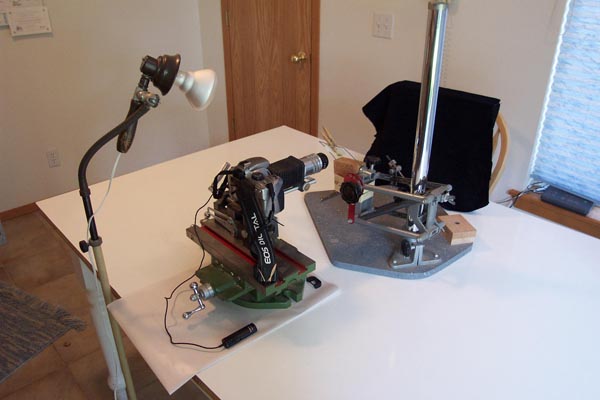
Processing Notes
In many cases, CombineZ5's "Do Stack" macro does a fine job.
However, in cases with dense overlapping hairs or bristles, Do Stack
can get confused and construct an image in which background objects
appear to be in front of foreground objects. That problem can
often be corrected by using the "Do Average and Filter" macro.
The images shown on this page were not
processed using "Do Stack". Instead they were
done with a modified "Do Average and Filter" macro, using
Highpass(1000,40). The images were then denoised using Helicon
Filter (not Helicon Focus) with settings (60,60,60). The
composite for the Sulphur head was contrast-balanced and color-balanced
against the single frame using Photoshop Unsharp mask 25% at 60 pixels,
plus a Levels adjustment layer.
The full-size images contain a couple of white streaks caused by
isolated "hot pixels" in the camera. For highest quality, these
artifacts would be removed either by manually cleaning up the final
images, or by preprocessing the source images to patch in the defective
pixels based on their surroundings.
Claims and Disclaims
The work presented here is a personal publication of
capabilities
and techniques developed by the author. You may link to this
page, but please do not reference
in archival publications; contact the author instead. All images
and text
are copyright Rik Littlefield, 2005.
-
- -




